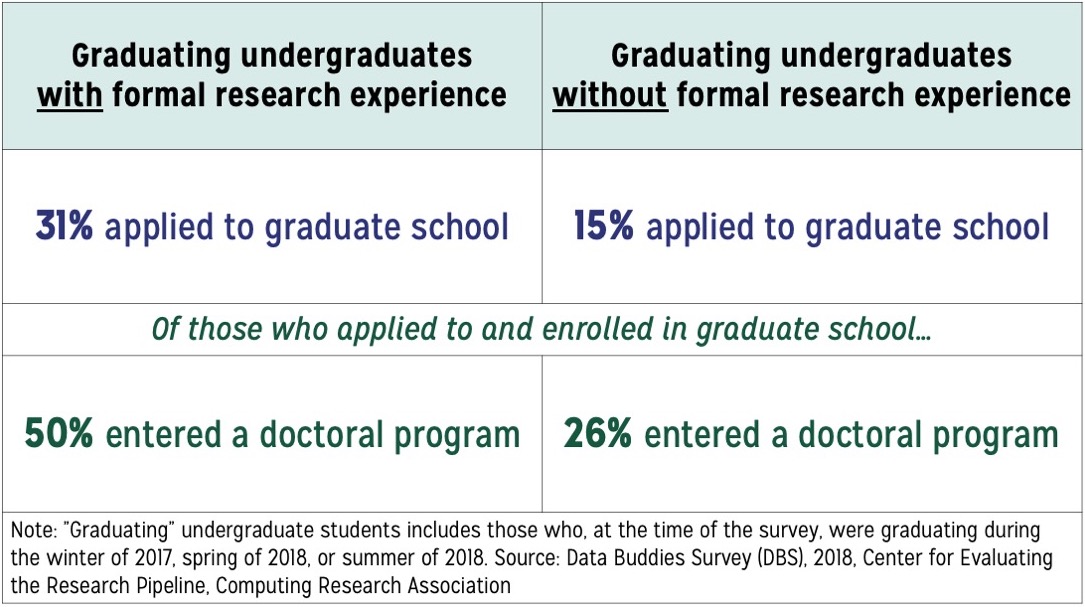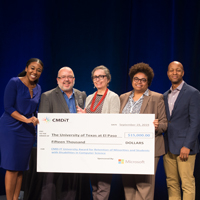One Year Later, CERP Data Still Indicate REU Participation Relates to Graduate School Enrollment

Using Data Buddies Survey (DBS) data collected during the spring of 2018, CERP found that among graduating undergraduate students in computing who had at least one formal research experience for undergraduates (REU) were proportionately more likely to apply to graduate school than those who did not participate in a formal REU (31% versus 15%, respectively). Of those who applied to and enrolled in graduate school, formal REU students were also proportionately more likely to have entered a doctoral program than those without a formal REU experience (50% versus 26%, respectively).
These results were also found using DBS data collected from graduating undergraduates during the spring of 2017, as previously published in Computing Research News. The DBS survey is designed to collect the same information from students on an annual basis, and as such, enables the possibility of replication from year-to-year. While these replicated findings do not prove a causal link between REUs and undergraduate students’ graduate school enrollment, they contribute to evidence supporting that REU participation relates to students’ likelihood to pursue graduate school after their undergraduate education.
Notes: “Computing students” were those who indicated their major(s) included at least one of the following: computer science, computer information systems/informatics, bioinformatics, computing and business, information technology, computer engineering, game design, data science, or “other computing” with a text box option for students to specify their major if it did not fit into one of the categories listed previously. “Graduating” students were those who, at the time of the survey, were graduating with their bachelor’s degree during the winter of 2017, spring of 2018, or summer of 2018. The total sample size of graduating computing students used in this analysis was n = 793.
The survey data used for this infographic were collected using four DBS questions: (1) During your college career so far, have you participated in any formal research experiences? [Yes; No]; (2) During the 2017-2018 school year, did you apply to graduate school? [Yes, I applied to one or more master’s programs; Yes, I applied to one or more doctoral programs; Yes, I applied to both master’s and doctoral programs; No, I did not apply to any graduate programs]; (3) What will you be doing during the fall of 2019? Select all that apply. [Attending graduate school in computing; Attending graduate school in a non-computing field; Working in a computing job; Working in a non-computing job; I am not sure because I am waiting to hear about grad school or job applications; Other]; and (4) What type of degree will you be pursuing? [Master’s continuation of a joint bachelor’s/master’s; Terminal master’s; Master’s (intend a doctoral degree but my program requires the master’s first); Doctoral; Other]. Question 4 was displayed to those who indicated they were either attending graduate school in computing or attending graduate school in a non-computing field in Question 3.
To test for differences between formal REU students and no-REU students, CERP ran two separate two-proportion z-tests. Statistical significance between proportions was determined using p ≤ .05.
 This analysis is brought to you by the CRA’s Center for Evaluating the Research Pipeline (CERP). CERP provides social science research and comparative evaluation for the computing community. Subscribe to the CERP newsletter here. Volunteer for Data Buddies by signing-up here.
This analysis is brought to you by the CRA’s Center for Evaluating the Research Pipeline (CERP). CERP provides social science research and comparative evaluation for the computing community. Subscribe to the CERP newsletter here. Volunteer for Data Buddies by signing-up here.
This material is based upon work supported by the National Science Foundation under grant numbers CNS-1246649, DUE-1431112, and/or DUE-1821136. Any opinions, findings, and conclusions or recommendations expressed in this material are those of the author(s) and do not necessarily reflect the views of the National Science Foundation.








